Updated: 22-Oct-2020
An engine design manufactured by the Swiss Machine Factory in Oerlikon. Originally, SWO or Schweizerische Werkzeugmaschinenfabrik Oerlikon. They made a single engine known by Oerlikon, name of the place.
-Oerlikon is also known for manufacturing weapons, air-ground rockets for airplanes, etc.
-The engine had four horizontally-opposed cylinders, but of a very rustic construction, even for the time, year 1910.
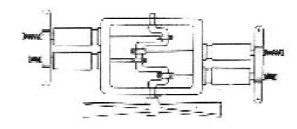
“Oerlikon top view drawing”
-It was water cooled and gave 50 hp at 1,200 rpm. It displaced 6.28 l. The pistons were 100 mm bore by 200 mm stroke.
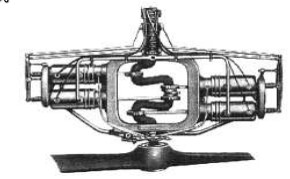
"Oerlikon engine top view”
-The most visible feature of the engine is its open crankcase in which we see a one-piece forged crankshaft, sinuously shaped. The engine has double ignition.

“Oerlikon at museum”
-At the Budapest Museum there is a unit that can be admired in its construction, without having to dismantle anything.
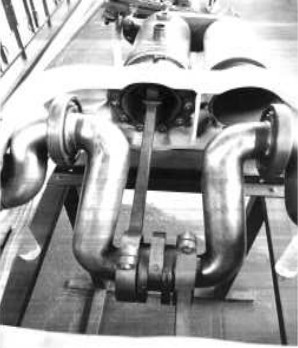
“Crankshaft detail”
-If at first glance the main characteristic that we can see is its "nakedness", there is another more internal one, which is the single valve per cylinder system, controlled by a double-length cam.
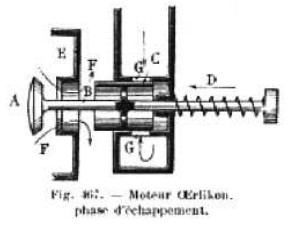
“Exhaust position”
-In this illustration the valve is in the exhaust phase. The valve stem is hollow and it closes or opens the ports of a double manifold depending on its position.
-The first lift produces the exhaust -closing the intake-, and hereafter the intake process follows, the valve advances further and opens the "mushroom" more inside the cylinder while the small inner piston changes the ports, closing the exhaust ports and opening the intake ones. Curious.
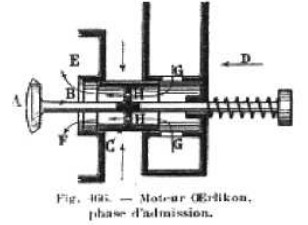
“Intake position”
From Appendix 6: From the Luzern Museum, we have a new detailed view of the Oerlikon engine with its bare crankcase. Focussed on the inside of the right-side cylinders where there are additional bottom dead center exhaust ports. (JGB photos).
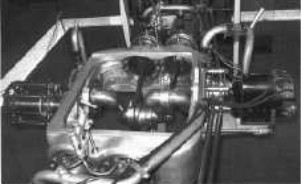
“Oerlikon detailed view”
-The oil lubricator dispensers for the cylinder walls are also clearly visible. In addition, the water circuit has drain taps at the outlet elbows of the cylinders to remove the air from the system at its high points.
-On the right are the valve control rods and the magneto with its four output cables.

“The Oerlikon engine at the Zurich Museum” (Photo JGB)
-The crankshaft bearings and the connecting rod heads seem to have to be abundantly lubricated before each operation.
-The construction of the crankshaft continues to amaze: a generous gauge rod conveniently bent.
-Another photograph by the same author on a visit to Zurich shows us the water pump on the front part, driven directly by the crankshaft.
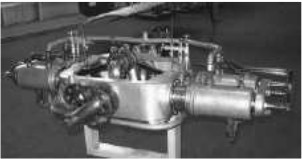
"Angled view of the same engine"
-The air bleed taps on the upper collector have disappeared from the Zurich Museum engine.
-The Oerlikon company is also known for air-to-ground rockets like the ones we show below from the mid-20th century.
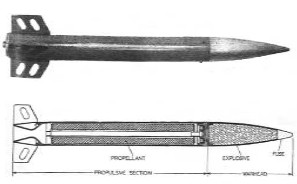
“Solid fuel rockets”
From Appendix 9: Oerlikon also made the Zenith Rocket engine.
-Below we show an ad for the four-cylinder boxer engine built between 1910 and 1914, "ideal for aviation". They were designed by the engineers Türler and Egg.

“Oerlikon ad of the time"
-Now we have obtained a cutaway of a cylinder in which we can see the exhaust ports at the end of the piston stroke.

"4-cylinder boxer engine cutaway"
And the installation of an Oerlikon engine on the Garuda plane, a small sunshade plane similar to the Bleriot.

"Garuda plane with Oerlikon engine"
From Appendix 10: We obtained a new photo of this 55 CV engine with an open crankshaft bed (see main text)
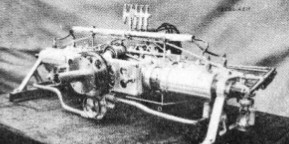
“Four-cylinder Oerlikon”
Engines of OERLIKON
Model: 4 cyl. boxer 50 hp
Arquitecture: 4-stroke4-cylinder Horizontally opposed
Cooling:
Total Displacement: 6280 cc
Bore / Stroke: 100 x 200
Power: 50 HP @ 1200 rpm
Weight: 80 Kg

"Oerlikon engine at museum"
Model: Zenith (rocket engine)
Arquitecture:
Chambers:
Fuels:
Feed System:
Ignition:
Thrust:
Weight:


